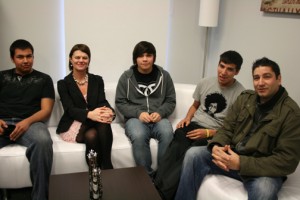Hi Everyone!
So here are my five weblog for module 1. I tried to stick within the themes of the module, and ended up going in a few directions. The websites have some focus on aboriginal education, and storytelling.
Weblog #1
http://www.aptn.ca/
Screen memories was really interesting so I decided to explore other media created by aboriginals and stumbled upon APTN (Aboriginal Peoples Television Network). There is a section of the website called “APTN Investigates” which “goes beyond the headlines to uncover the truth behind the most controversial Aboriginal news stories”. I also stumbled upon an interesting news story by CBC that I thought was somewhat fitting to my weblog as well as our discussions surrounding the importance of indigenous people portraying their own history as well as their own current events.
http://www.cbc.ca/news/canada/story/2013/05/27/f-mustang-tv-wabasca-mistassiniy-cree-education.html?cmp=rss
This is a link to a news article by CBC regarding “Mustang TV” at Mistassiniy School, which is 4 hours north of where I live. The concept of the TV show reminded me of the article Screen Memories by Ginsburg, but what really made me ponder was the fact that the TV show is not the main point of the article which continually points out the drug, alcohol, and gang issues that are going on within the community as well as the lack of poor attendance at the school. After reading the article and some of the comments I have realized that the article is written from the perspective of someone outside of Wabasca, AB where the school is located. Why does the article focus on the problems of the community rather than celebrating something that encourages students to be more emotionally involved at school?
Weblog #2images and information are the property of AMMS
http://www.ammsa.com/publications/alberta-sweetgrass/indian-control-over-indian-education-remains-focus
In light of our discussions about whether education for indigenous people is different than what the current education system provides this is an interesting article on how aboriginal people should be educating aboriginal people, which I found on The Aboriginal Multi-Media Society’s (AMMSA) website. http://www.ammsa.com/. This website has tons of different publications to access.
Weblog #3
http://www.education.gov.sk.ca/Storytelling
I was on the Government of Saskatchewan’s education website and found a really interesting article by Melanie Mac Lean and Linda Wason-Ellam. They conducted a research study using conversational interviewing to explicate how teachers use storytelling as a teaching practice throughout the curriculum. Seven First Nations and Métis teacher-participants were asked how, why and when storytelling was integral to their professional practices.
Weblog #4
http://aboriginaleducation.epsb.ca/
To further explore our question in week 3 regarding whether education for indigenous people is different I decided to explore the Edmonton public school’s website regarding our education system in Edmonton and how the schools try to recognize and more importantly incorporate Aboriginal values.
The goals of Edmonton Public Schools are:
- increase Aboriginal representation at all levels of Education (Elder Consultation);
- understand and utilize Aboriginal protocol at all levels;
- increase Post Secondary opportunities for Aboriginal students;
- increase the number of Aboriginal student leaders;
- identify culturally sensitive assessment practices resulting in more accurate and decreased coding of Aboriginal students;
- create opportunities for Aboriginal parental involvement at various levels within Edmonton Public Schools.
Weblog #5
The Math Catcher: Mathematics Through Aboriginal Storytelling project includes the creation of a series of short animated films that accompany picture books, as well as the development of related activities that introduce math topics and techniques through stories that follow Aboriginal storytelling formats and contain elements of Aboriginal traditions and cultures.
http://mathcatcher.irmacs.sfu.ca/
Enjoy your weekend!
Kiersten

